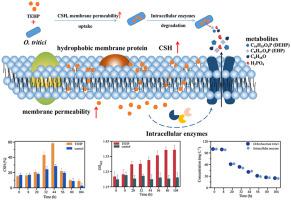Chemosphere ( IF 8.1 ) Pub Date : 2022-10-31 , DOI: 10.1016/j.chemosphere.2022.137071 Jiamei He 1 , Zeyu Wang 2 , Fengzhen Zhen 3 , Zhaoyun Wang 1 , Zhongdi Song 2 , Jun Chen 2 , Dzmitry Hrynsphan 4 , Savitskaya Tatsiana 4

|
Tris (2-ethylhexyl) phosphate (TEHP) is a common organophosphorus flame retardant analog with considerable ecological toxicity. Here, novel strain Ochrobactrum tritici WX3-8 capable of degrading TEHP as the sole C source was isolated. Our results show that the strain's TEHP degradation efficiency reached 75% after 104 h under optimal conditions, i.e., 30 °C, pH 7, bacterial inoculum 3%, and<initial concentration 100 mg L−1. The biodegradation efficiency of cell and intracellular enzymes were 75–76%. A consistent degradation trend was observed, with the cellular surface hydrophobicity being increased from 21 to 58% after 24 h while the biodegradation efficiency being increased from 29 to 59% after 20 h. The data indicate that TEHP increased the cell surface for better biosorption to enter the cell more easily, which was decomposed via intracellular enzymes. Furthermore, the membrane permeability increased with time from 1.22 to 1.39 during 104 h degradation, supporting that TEHP changed the surface structure of cells to promote entry into cells for degradation. Further metabolic pathway analysis revealed the possible TEHP biodegradation metabolic pathway as: tri (2-ethylhexyl) phosphate → di (2-ethylhexyl) phosphate → mono (2-ethylhexyl) phosphate → phosphoric acid and generated 2-ethylhexanol. Results showed that TEHP was transformed by O-dealkylation. This research suggests the viability of using novel strain WX3-8 for TEHP as a cost-effective and environmentally-friendly strategy for bioremediation applications of TEHP in the environment.
中文翻译:

新型菌株小麦苍白杆菌WX3-8生物降解阻燃剂磷酸三(2-乙基己基)酯的机制
磷酸三(2-乙基己基)酯 (TEHP) 是一种常见的有机磷阻燃剂类似物,具有相当大的生态毒性。在这里,分离出了能够作为唯一碳源降解TEHP的新型菌株小麦苍白杆菌WX3-8。结果表明,在最佳条件下,即30℃、pH 7、菌量3%、<初始浓度100 mg L -1 ,104 h后该菌株的TEHP降解效率达到75 %。细胞和细胞内酶的生物降解效率为75-76%。观察到一致的降解趋势,24小时后细胞表面疏水性从21%增加到58%,而20小时后生物降解效率从29%增加到59%。数据表明,TEHP 增加了细胞表面,以便更好地生物吸附,更容易进入细胞,并通过细胞内酶分解。此外,在104小时的降解过程中,膜渗透性随着时间的推移从1.22增加到1.39,支持TEHP改变细胞的表面结构以促进进入细胞进行降解。进一步的代谢途径分析揭示了TEHP可能的生物降解代谢途径为:磷酸三(2-乙基己基)→磷酸二(2-乙基己基)→磷酸一(2-乙基己基)→磷酸并生成2-乙基己醇。结果表明TEHP是通过O-脱烷基化转化的。这项研究表明,使用新型菌株 WX3-8 进行 TEHP 作为 TEHP 在环境中生物修复应用的一种经济有效且环保的策略是可行的。






























 京公网安备 11010802027423号
京公网安备 11010802027423号